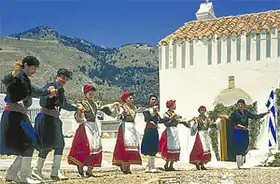
Mayim Mayim (Hebrew: מים מים, "water, water") is an Israeli folk dance, danced to a song of the same name. It has become notable outside the Israeli dancing community and is often performed at international folk dance events.
History
The dance was created in 1937 for a festival to celebrate the discovery of water in the desert after a seven-year search. The choreographer was Else I. Dublon.[1]
The dance is sometimes known as "Ushavtem Mayim", after the first words of the lyrics, or simply just "Mayim", but "Mayim Mayim" is the original and most common name. The movement to the first four counts has become known as the "Mayim step" and is similar to the grapevine step found in other forms of dance.
"Mayim Mayim" is done in a circle formation, facing the center through most of the dance, and holding hands except when clapping.[2]
| Count | Step |
| Part 1 | |
| 1–4 | Grapevine: Step R foot across in front of L foot, step on L foot to L, step on R foot behind L foot, step on L foot to L (turning a bit as you go, so that the R foot goes more forward and backward, rather than directly crossing) |
| 5–16 | Repeat counts 1–4 three more times |
| Part 2 | |
| 1–4 | Run four steps forward, R L R L. Begin leaning forward with arms down on 1, then straighten up and raise arms during 2–4. |
| 5–8 | Take four steps backwards, R L R L, bringing arms back down again. (A variation, more recent than the first version given here, is to clap on count 5 before beginning to bring the arms down, while in an earlier version the arms are brought down on 5.) |
| 9–16 | Repeat counts 1–8 |
| Part 3 | |
| 1–3 | Facing left, run three steps forward around the circle, R L R |
| 4 | Face center while hopping on R and touching L foot slightly to the side. (In another variation, a fourth step is added here, onto the L foot, and the rest of this part is done with opposite footwork.) |
| 5–6 | Facing center, hop on R foot while touching L toe in front, hop on R foot while touching L to side, near R foot and slightly to the back. |
| 7–12 | Repeat counts 5–6 three more times, and on 12 transfer some weight onto L foot. |
| 13–20 | Repeat counts 5–12 with opposite footwork and clapping hands each time you touch R in front, finishing with R foot free to start Part 1 again. (In yet another variation, some people turn while doing counts 13–20). |
The song
The music for Mayim Mayim was composed by Emanuel Pugashov Amiran with lyrics taken from the Book of Isaiah, chapter 12 verse 3,[3][4] "Joyfully shall you draw water from the fountains of triumph".[5]
- Ushavtem mayim b'sason mimainei hayeshua
- Ushavtem mayim b'sason mimainei hayeshua
- Mayim mayim mayim mayim, hey, mayim b'sason
- Mayim mayim mayim mayim, hey, mayim b'sason
- Hey, hey, hey, hey
- Mayim mayim mayim mayim mayim mayim b'sason
- Mayim mayim mayim mayim mayim mayim b'sason
Appearances in gaming
- An 8 bit arrangement appears in the Game Boy Camera's Ball minigame.[6]
- A 16 bit arrangement appears in the Super Famicom port of ClockWerx.[7]
- A remixed version appears in Konami's Sexy Parodius.[8][9]
See also
References
- ↑ "Mayim Mayim", Information about the dance and links to the dance steps and music as originally published. Israelidances.com. Retrieved 2009-04-09.
- ↑ Mayim-Mayim - Palestine Folk Dance Series No. 3, by Gert Kaufmann, Zionist Organisation Youth Department. Israel: Tel Aviv, 1946.
- ↑ וּשְׁאַבְתֶּם-מַיִם בְּשָׂשׂוֹן מִמַּעַיְנֵי הַיְשׁוּעָה
- ↑ "Mayim, Mayim". Lyrics in English translation and Hebrew romanization. Hebrewsongs.com. Retrieved 2009-04-09.
- ↑ JPS Hebrew-English Tanakh. Jewish Publication Society, 2003.
- ↑ Game Boy Camera Ball - YouTube
- ↑ [https://www.youtube.com/watch?v=775v_wDaNr4 Clockworks SNES OST 04 Level Music 3 - YouTube]
- ↑ Wawro, Alex. "Tracing the path an Israeli folk song took to end up in Japanese video games". www.gamasutra.com. Retrieved 2021-04-26.
- ↑ "A Jewish folk song is preserved in a Japanese video game". The World from PRX. Retrieved 2021-04-26.
Further reading
- Goldschmidt, Matti: The Bible in Israeli Folk Dances, Viersen 2001
